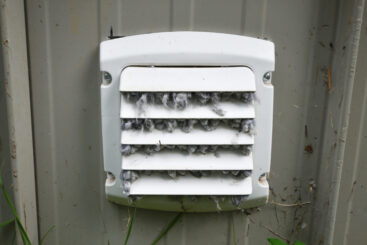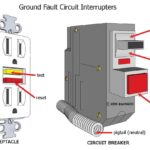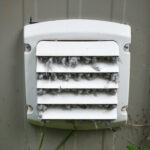GFCI and AFCI Protection
What is a GFCI? Continue Reading
27 Apr

Clothes dryers are often neglected by the homeowner. It’s easy to forget about it as long as it’s still doing its job of dryer clothes. However, the duct must vent directly to the outdoors and be free of obstructions, like built up lint. Which can be a fire hazard.
A clothes dryer will vent about a gallon of water for each load of laundry. If the dryer vent discharges into a crawlspace, attic, or other building cavity, the potential for moisture-related damage is significant. Clothes dryers must vent directly to the outside.
Dryers should use approved exhaust ducts. Ducts made of vinyl, nylon or foil are not recommended. Spiral-duct designs often trap lint, which can clog the duct, requiring the dryer to work harder and longer to dry clothes and causing it to increase the dryer’s temperature. Not only is a poorly exhausting dryer less efficient, it can also be a fire hazard due to the flammability of the accumulated lint.
The duct should be as short, straight and horizontal as possible. The moist air, along with the lint should have an easy time exiting the building.
There should be minimal bends in the duct with proper supports and no sagging, which can trap lint.
The exhaust duct should terminate outside the building away from any building opening, or an air conditioner. The duct termination should be fitted with a closable damper (a backdraft damper). A screen may not be installed at the duct terminus, as it can trap debris, which poses a fire hazard.
The leading cause of fires from clothes dryers is the failure to clean the lint and other debris that can accumulate in and around them. Here are some recommendations for homeowners:
Summary
Electric and gas dryers make our lives much easier and it’s easy to forget the duct system, they are usually out of sight, out of mind. But, it’s important to maintain this system as it can prolong the life of your dryer and avoid fires.

Posted on Nov 14/2021 By Cameron Jaggs
If you’re looking to keep your home’s heating and air conditioning system in good condition, you’ll need to be proactive. Keep these HVAC maintenance tips in mind and follow through with them throughout the year.

Posted on Apr 27/2021 By Castle Tech Inspections
How often do you clean your dryer ducts?
Proudly serving Newmarket home inspection, Aurora home inspection, Richmond hill home inspection, Markham home inspection, Vaughan home inspection, Toronto home inspection, North York home inspection, Scarborough home inspection, Pickering home inspection, Oshawa home inspection, Whitby home inspection, Mississauga home inspection, Etobicoke home inspection, Burlington home inspection, Oakville home inspection, Hamilton home inspection, Keswick home inspection, Sharon home inspection, Bradford home inspection, Barrie home inspection, Best home inspection, Best home inspector

What is a GFCI? Continue Reading

Clothes dryers are often neglected by the homeowner. It’s easy to forget about it as long as it’s still doing its job of dryer clothes. Continue Reading
The comments are closed.